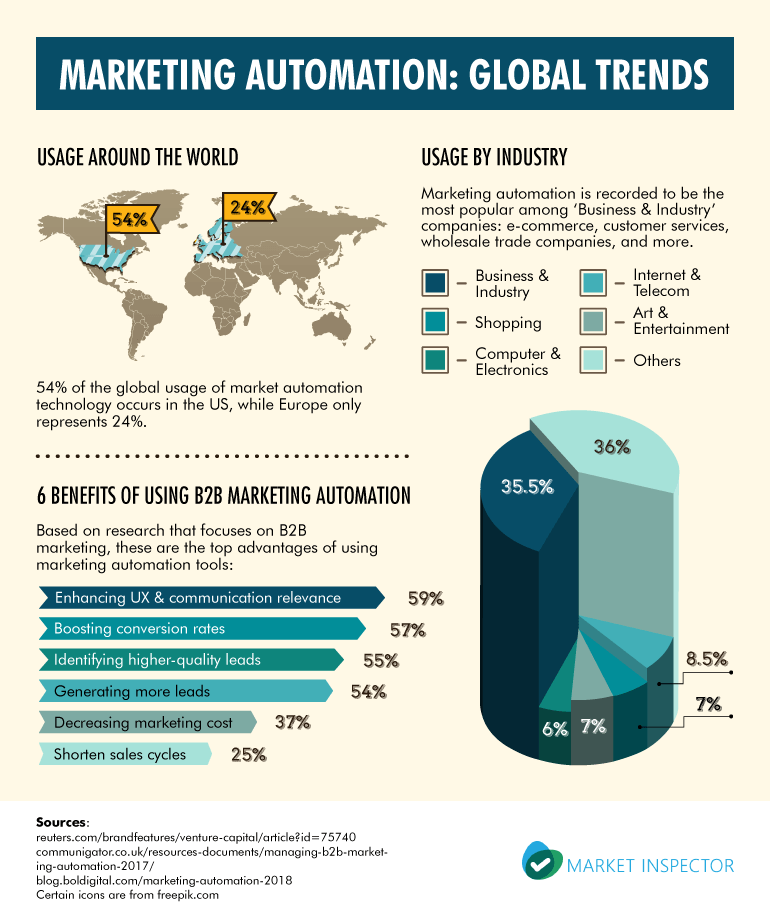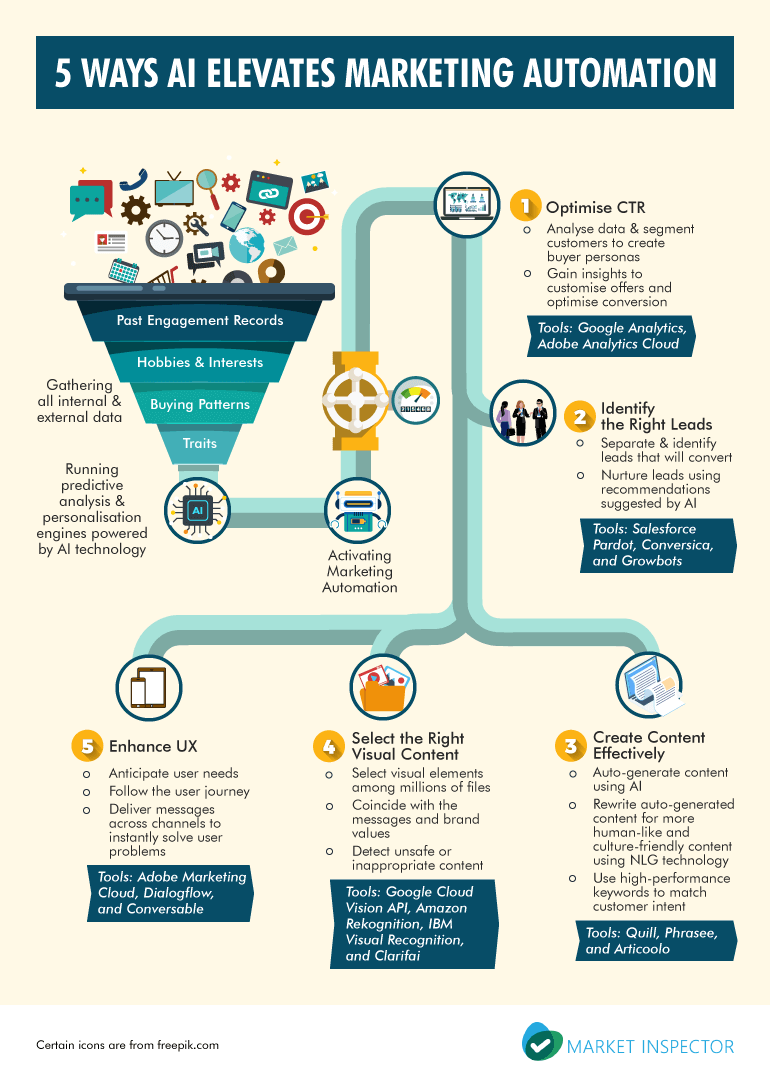- Market-Inspector.co.uk
- Blog
- How AI Leverages B2B Marketing Automation
How to Use AI To Elevate Your B2B Marketing Automation Strategy
Marketing automation refers to a set of tools designed to manage marketing processes automatically, on multiple digital channels, handling presets of repetitive tasks. This automation helps minimise human error, while maximising smart working.
Technically, marketing automation helps marketers and sales teams streamline and simplify some of their most time-consuming everyday assignments, giving them more time to focus on growing the business and driving revenue and ROI.
In this new in-depth guide done by Market Inspector, we cover:
The marketing automation market is undoubtedly growing, gaining a foothold in multiple markets and industries. Data shows that, in 2017, the USA became the largest region consuming marketing automation software in the whole world at 54%, while Europe consisted of 24%.
The market of marketing automation is becoming increasingly valuable, reaching an expected compound annual growth rate of 9.26% by 2022, and generating up to £5.88 billion revenue by 2025.
According to Bold Digital, marketing automation technologies are most popular in the ‘Business & Industry’ sector, comprising 35.5% of the market. These organisations include e-commerce, customer service, wholesale trade businesses, and more. Coming in second place are companies in the ‘Internet & Telecom’ sector, the ‘Art & Entertainment’, and the ‘Shopping’ sectors, which make up roughly 8% of the market each.
Furthermore, 53% of B2B companies have implemented marketing automation in their day-to-day businesses, and a further 37% are planning to adopt the technology, as reported by eConsultancy.
The 5 key benefits of using marketing automation in your B2B practices are:

If you would like to use this infographic on your website, use the embed code below:
Artificial Intelligence Comes to Marketing Automation
Artificial Intelligence (AI) and machine learning (ML) are growing faster than ever before, permeating many departments of businesses. And there is no doubt that AI can help leverage many aspects of small businesses.
The global market revenue is anticipated to soar by almost 20 times compared to 2017 stats, reaching £69.25 billion by 2025.
And, with its powerful ability to simulate human intelligence, AI has come to benefit marketing automation too. Marketing automation actions are based on parameters pre-programmed by a person. While this might help to make things easier to carry out repetitive tasks, they are far from tailoring and personalising customer interaction.
Salesforce research shows that 83% of business buyers consider the individualised experience a business provides as key when making their buying decision. Furthermore, 65% of business consumers affirm that they would switch brands if an organisation did not make an effort to customise communication.
But, with AI bringing predictive analysis and personalisation engines to marketing automation, businesses’ B2B marketing strategies will become more human-like. Not only will AI be able to deliver relevant messages, but also make decisions on its own.
5 Ways Your Current Marketing Automation Strategy Can Benefit from AI
Data shows that the development in AI in the automation market is projected to accrue £11.8 billion in revenue by the end of 2019. However, there are businesses that still find it difficult to implement the full potential of AI when automating their marketing processes. It can be due to lack of knowledge or skills, or a reluctance to make operational changes.
Artificial intelligence does not solve all your problems – using it well, does.
To effectively execute the technology advancement, here is how to elevate your marketing automation using AI.
Optimising Conversion Rates
By helping your business answer the most significant questions, AI can help to segment customers based on their activities, purchasing patterns, or behavioural traits, to ultimately creating real-time, well-defined, and elaborate buyer personas.
As a result, your marketing team can have actual insights into who should they concentrate on. AI allows you to easily customise your offers to meet customer’s exact needs, consequently ensuring a higher conversion rate.
There are multiple tools available on the market that can support marketers in the process of segmenting customers. The most famous one is Google Analytics. It is definitely a powerful tool and, fortunately, free of charge. Businesses can also make use of Adobe Analytics Cloud, including Adobe Analytics and Adobe Audience Manager.
Identifying the Right Leads
Not all the leads are the right leads. Or, in other words, not everyone is ready to convert the moment they learn about your business. By using AI, you can quickly separate and identify the leads that have higher conversion potential.
Other than that, AI also helps with lead nurturing as it gives your business recommendations for touchpoints that are most applicable to that specific lead.
Platforms such as Salesforce Pardot, Conversica, and Growbots analyse millions of prospects, progressively profiling to keep your sales pipeline fully stocked with a steady flow of high-quality leads.
Creating Content Effectively
One of the key value propositions of AI for marketers is that it can produce creative content that is relevant to your potential customers, using multiple data inputs.
Thanks to Natural Language Generation (NLG) technologies, your business now can create marketing content that matches a global and multicultural audience with a more human approach, while still using high-performance keywords to match customer intent.
In this field, businesses can find tools like Quill, which promises to deliver unique written content 75% faster than in-house producing. Articoolo can also help rewrite your business’ old content.
More impressive yet, Phrasee uses past data of your campaigns to build a behavioural model of how your audience engages with it, to craft new content for your email campaigns subject lines, social media ads, and push notification copywriting.
Selecting the Right Visual Content
To maximise the impact of visual content, AI allows marketers to effortlessly select the right visual elements among millions of files within seconds, which coincide with the marketing messages and the brand’s visual identity.
Nowadays, there are various visual recognition solutions, such as Google Cloud Vision API, Amazon Rekognition, IBM Visual Recognition, and Clarifai. These softwares can detect object, scene, activity, recognise faces, and better yet, identify potentially unsafe or inappropriate content throughout image and video assets.
Enhancing User Experience (UX)
To boost user experience, you need to put the user at the centre of your intention, delivering the right message and answering the right question in a timely manner.
Thanks to the introduction of AI, it will help your business anticipate user’s needs throughout their customer journey, instantly deliver intuitive and intelligent messages across channels, all in an effort to solve all their problems before they even notice.
Adobe Marketing Cloud package is a capable set of tools. Even though it is quite pricey, the package has been nominated as the Leader in Cross-Channel Campaign Management by Forrester in Q1 2018. There are other less expensive tools in the market, such as Dialogflow and Conversable, which can deliver automated messages using AI-powered chatbots to voice assistants. All those tools have website-integration option when your business needs truly functional web design.

If you would like to use this infographic on your website, use the embed code below:
Keep Up with AI Technology Advancement
No matter how useful your marketing automation tools are, they can’t be as efficient as they can be when integrating a new dimension to it with the help of AI.
As AI technology continues to advance, businesses will have more chances to get more out of their automation efforts, and get closer to their customers.
We strive to connect our customers with the right product and supplier. Would you like to be part of Market Inspector?

